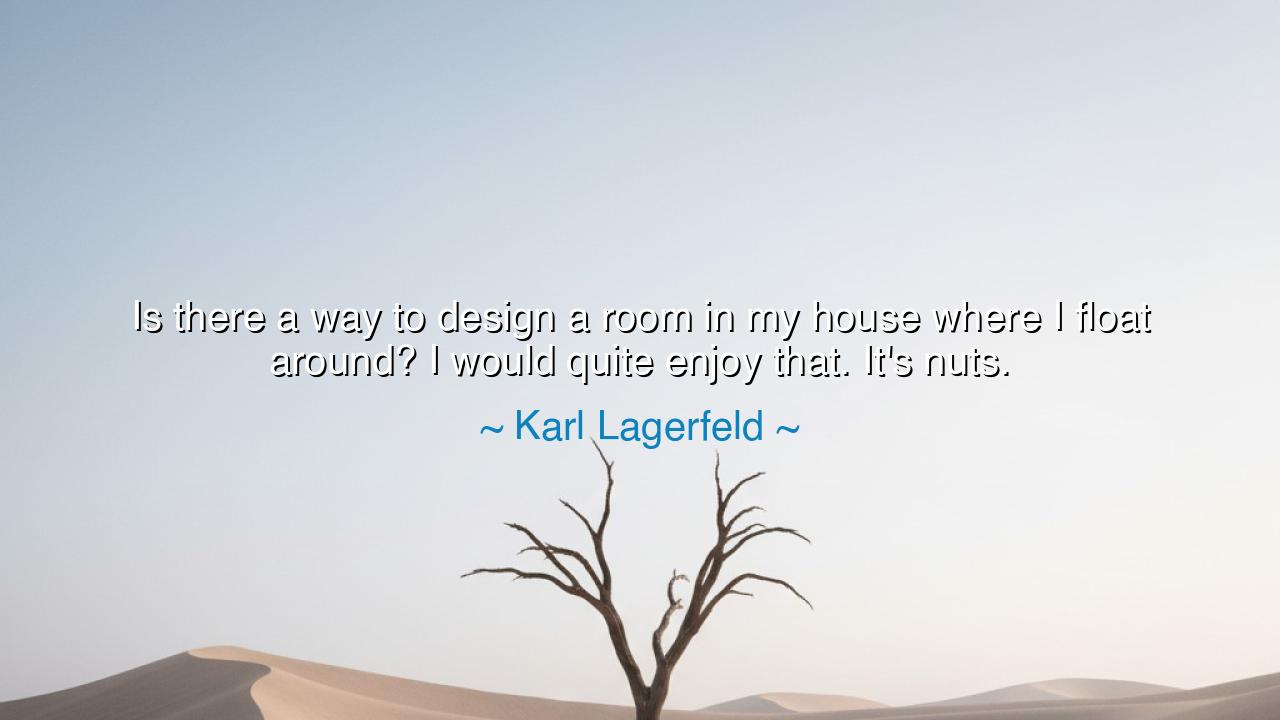
Is there a way to design a room in my house where I float around?
Is there a way to design a room in my house where I float around? I would quite enjoy that. It's nuts.






The legendary designer Karl Lagerfeld, a man whose imagination often exceeded the limits of the tangible world, once mused: “Is there a way to design a room in my house where I float around? I would quite enjoy that. It’s nuts.” At first hearing, these words sound whimsical—perhaps the idle dream of a man accustomed to creating beauty from fantasy. Yet beneath their humor lies something profound: a longing for weightlessness, for liberation from the heaviness of the ordinary. Lagerfeld, who lived in the realm where art meets invention, gives voice here to the eternal human desire to defy gravity—not merely the gravity of the body, but the gravity of life itself.
In this seemingly playful question—“Can I design a room where I float around?”—Lagerfeld is not merely speaking of architecture or design. He is speaking of freedom, the yearning of the spirit to rise beyond constraint. To “float” is to move unbound, released from the burdens of expectation, time, and even self. For an artist like Lagerfeld, who spent his life shaping fabric into visions and transforming rooms into cathedrals of fashion, this was not madness—it was the purest expression of imagination. He understood that design, at its highest form, is not decoration but transcendence: the power to transform reality into dream.
The ancients, too, shared this hunger for the impossible. The architects of Egypt sought to pierce the heavens with their pyramids, while the inventors of Greece, like Daedalus, built wings of wax to escape the labyrinth. Each generation has dreamed of floating—of freeing itself from the weight of the earth. Even Leonardo da Vinci, centuries before the first airplane, filled his notebooks with sketches of flying machines, driven by that same question Lagerfeld posed in jest: Is there a way? For within every creative soul lies this defiance, this refusal to accept the limits of the known world.
Lagerfeld’s “floating room” is, in truth, the metaphor of a restless mind. He was not content to live as others lived, nor to design as others designed. His art was not born from stability but from motion—an unending pursuit of novelty and surprise. He saw the world as something to be reinvented daily, each space, each garment, a new possibility for wonder. To imagine a room where one could float is to imagine a life unanchored by convention, where the artist moves effortlessly through ideas as a swimmer moves through water. Such a vision might be “nuts,” as he himself admitted, yet it is in madness that genius often hides.
Consider Archimedes, the ancient scientist who discovered the principle of buoyancy while bathing. When he realized that an object’s weight could be countered by the water it displaced, he cried “Eureka!” and ran naked through the streets. In that moment of revelation, he too had found a way to float—not in defiance of nature, but in harmony with it. His joy was the same as Lagerfeld’s: the exhilaration of discovering a new balance between weight and freedom, between the real and the imagined. Both men remind us that creativity begins when we ask the impossible question, when we dare to wonder how we might make the heavy light again.
The lesson, then, is this: never stop asking impossible questions. The world advances not through certainty but through curiosity, through the willingness to imagine what has never been done. When you feel bound by circumstance or routine, let Lagerfeld’s whimsical challenge awaken your courage to dream differently. Ask yourself—how might I float? Not in body, but in spirit. How might I lift myself above the dull gravity of fear, habit, and doubt? The floating room is not a place—it is a state of mind.
So, my child, remember the wisdom hidden in Lagerfeld’s jest. Innovation begins with wonder, and wonder begins with play. Do not fear to dream “nuts” dreams; they are the seeds of all progress. If the world says you cannot float, ask again, and design a way. For every act of imagination is an act of flight, and every dreamer who dares to rise, even for a moment, becomes lighter than the world that tries to hold them down.






AAdministratorAdministrator
Welcome, honored guests. Please leave a comment, we will respond soon